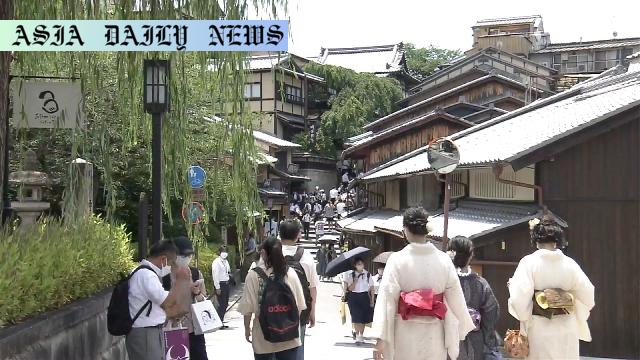Kyoto Tourism: Foreign visitors overtaking domestic travelers in 2022
Record 16.3 million people stayed overnight in Kyoto last year.
Over 8.2 million foreign tourists visited Kyoto, surpassing domestic visitors.
Rising accommodation fees deter Japanese travelers from overnight stays.
Kyoto aims to achieve sustainable tourism while considering locals’ lives.

Kyoto Sets a New Record with 16.3 Million Visitors
In a remarkable milestone for the historic city of Kyoto, more than 16.3 million people stayed at least one night in the city last year, marking a record high. This represents a year-on-year increase of about 1.5 million visitors, demonstrating the city’s growing global attraction among travelers. The statistics, released by the Kyoto city government, reveal that for the first time, the number of foreign tourists exceeded that of Japanese travelers. Out of the total, over 8.2 million foreign tourists spent at least one night in Kyoto, overtaking the approximately 8 million Japanese travelers who did the same.
Foreign Tourists Lead the Surge in Numbers
The drastic increase in foreign tourists underscores Kyoto’s appeal on the international stage. Factors such as the city’s rich cultural heritage, iconic landmarks like Kinkaku-ji and Fushimi Inari Shrine, and its reputation as the cultural capital of Japan likely contributed to this growth. The Japanese yen’s exchange rate might have further incentivized foreign travel to Japan, with Kyoto being a must-visit destination. Meanwhile, Japanese tourists showed a slight decline in overnight stays, possibly influenced by rising accommodation fees in the city.
Sustainability Efforts Amid the Boom
While the boom in tourism is undoubtedly an economic boost, the Kyoto city tourism promotion officials are emphasizing the importance of sustainable tourism. The city aims to strike a balance between the benefits of tourism and the quality of life for its residents. Considering the dense influx of tourists, measures are being taken to ensure minimal disruption to locals. This includes managing overcrowding at famous sites and addressing concerns about inflated housing costs due to increased demand for short-term rental accommodations.
Challenges and Future Goals
Despite the impressive numbers, challenges remain. Feedback from the local community has highlighted concerns over noise, traffic congestion, and the monetization of cultural areas. Tourists themselves sometimes report frustrations with crowded attractions or long wait times. Moving forward, Kyoto’s goal is not just to maintain the impressive tourist influx, but to create a harmonious environment that works for visitors, residents, and the city’s infrastructure.
What Lies Ahead for Kyoto?
Looking ahead, Kyoto is working on sustainable initiatives such as encouraging day trips to surrounding regions, promoting off-season travel, and implementing tourist taxes to control numbers. Preserving Kyoto’s charm while accommodating millions of travelers will take careful planning and collaboration between government bodies, local businesses, and international travel agencies. Additionally, leveraging technology could help improve services and reduce bottlenecks in high-traffic areas, ensuring that Kyoto continues to thrive as one of Japan’s most beloved destinations.
Commentary
An Analysis of Kyoto’s Record-Breaking Tourism Numbers
The recent data on Kyoto’s record-breaking 16.3 million overnight visitors is a testament to the city’s enduring appeal. This milestone is especially noteworthy because it signifies Kyoto’s growing relevance not only to domestic tourists but also on the global stage. For a city that relies heavily on tourism for economic drivers, this upward trajectory provides a source of optimism and ensures that the world continues to celebrate its cultural and historical significance.
Impacts on Local Life and Culture
However, it’s impossible to ignore the challenges presented by such an influx of visitors. While tourism drives local business growth and increases international exposure, its implications for residents cannot be understated. Rising accommodation prices, overcrowded tourist landmarks, and increased pressure on public infrastructures are tangible concerns. This duality of tourism as both an economic boon and a disruptive force requires careful management by city officials and the community.
The Road to Sustainable Tourism
Kyoto’s emphasis on sustainable tourism is commendable, and continuing this effort will be key to maintaining the city’s allure. Encouraging day trips to surrounding areas or promoting lesser-known attractions could distribute tourist activity more evenly across the region, alleviating the pressure on hotspots. Likewise, engaging with tourists about their responsibilities as visitors—from preserving cultural sites to respecting local customs—could mitigate some of the negative impacts associated with mass tourism.
A Vision for the Future
In conclusion, Kyoto’s record-breaking numbers are cause for celebration, but they also present an opportunity to rethink and refine tourism strategies. With thoughtful planning, continued community involvement, and innovative solutions, Kyoto can remain a world-class destination while respecting the needs of its residents. This balance is not only desirable but necessary for its future prosperity.


